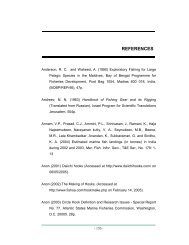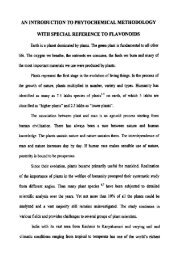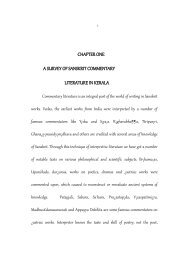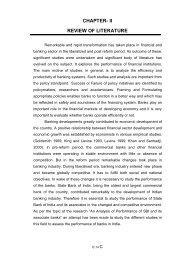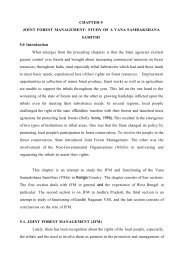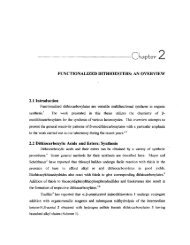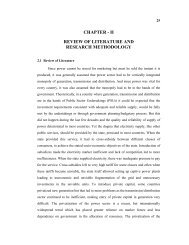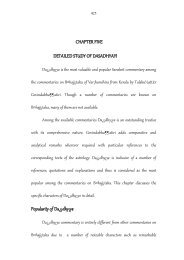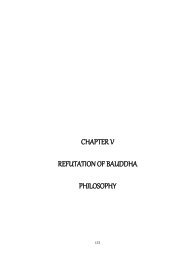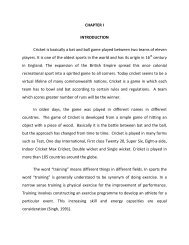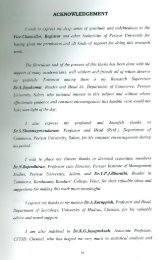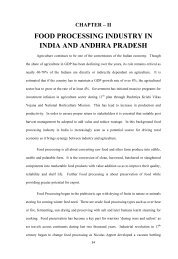Changing Vaiphei Society: A Geographical Study
Changing Vaiphei Society: A Geographical Study
Changing Vaiphei Society: A Geographical Study
You also want an ePaper? Increase the reach of your titles
YUMPU automatically turns print PDFs into web optimized ePapers that Google loves.
<strong>Changing</strong> <strong>Vaiphei</strong> <strong>Society</strong>: A <strong>Geographical</strong> <strong>Study</strong>(Abstract)A thesis submitted in fulfilment of the requirement for theDegree ofDoctor of Philosophy (Ph.D)SoilalsiamDEPARTMENT OF GEOGRAPHYSCHOOL OF HUMAN AND ENVIRONMENTAL SCIENCESNORTH-EASTERN HILL UNIVERSITYSHILLONG2009
11. IntroductionGeographers have long been accustomed to study the change of landscape wroughtby nature itself and indiscriminate use of nature due to biotic pressure. The placement oftribes in spatial segments may be an outcome of a social history of contact, confrontationand contestation between the ethnically differentiated tribes. Any understanding of socialchange remains incomplete without a proper conceptualization of its spatial parameters. Itis a common place of understanding that the nature, direction and pace of social changeare never uniform in its spatial coverage. The organized and socially concretized spaceprovides friction to a uniform spread of social change; thereby making socialtransformation spatially fragmented response. The geographical distribution of differentsocial categories differentiates the impact of social change as diverse categories havedifferent capacities to respond to the changes affecting them (Chandra, 1991). Thus, therate of social change may be phenomenal in areas which have experienced large scaleagrarian development historically, whereas, the dominantly tribal areas have been onlymarginally exposed to such changes. The pace and direction of social change would bedetermined to a great extend by the limits imposed by the nature or human freedom andthe capacity of man to overcome such constraints through his own creativity anddynamism. Therefore, change is observed over space i.e. areal or spatial variations. In caseof the <strong>Vaiphei</strong> tribe also, change is seen over two areas; the area of concentration and thearea of dispersion over different periods of time.Social change is essentially a change of social structure like population change andchanges in the relationship of the components of the social structure. The position and roleof the individual has also change over a period of time. In static society, the status and roleof the individual do not undergo noticeable change from generation to generation. Adynamic society is one where basic social changes occur. The process of social changewithin the tribal societies have consequently operated at a low key, perpetuating the oldermode far too long and thus leading to a socio-economic stagnation of a high order. Therigorous environment acted as a constraint and fostered physical and social isolation for
3literacy and about socio-economic conditions of the different tribes. Ansari pointed outthat the two most important factors, which effected changes in tribal life, is conversion toChristianity and spread of education. These changes have raised the tribal communities toa higher social pedestal. Apart from these two factors, the Five Year Plans also greatlycontributed to the advancement in the socio-economic of the tribes.Breese (1969) observed that developing countries are experiencing rapidpopulation explosion resulting in large-scale unemployment in the rural country side. Thishas generated incessant swing of migration from one region to another or from rural tourban and industrial centre in search of job opportunities. Rural-urban migration hasspecial significance for the developing countries, as this constitutes a major component ofthe process of urbanization taking place in those parts of the world.Casette (1979) examined the spatial temporal dynamics of out migrations,economic development and population growth in Europe during the war period. Themassive movement occurred as Europe went through social and economic changes similarto the ones currently in the less developed countries.Das (1985) unfolds the richness of social anthropological data in Manipur andseeks to examine the relationship between the various tribes and the Meiteis, whodominate the scene. By virtue of their dominant position, the Meiteis probably influencedthe course of the tribal history in Manipur more than the tribes themselves did. But,however successful they might in exerting political influence, it could not affect the coreof tribal cultures. He emphasized on the trends of change among the tribes of Manipur.Green (1974) in a study of temporal model of migration in Nigeria postulated thatthe principal population movement took place from more developed areas to lessdeveloped areas of an agricultural country possessing vast and virtually uninhabited partsof virgin land.Harbison and Myers (1963) have identified three methods of human resourcedevelopment for socio-economic change: (i) by formal education, beginning with primaryand ending with university education, (ii) by on-the-job through systematic or informaltraining programmes in employing institutions, (iii) by self development as individual
4seeks to acquire greater knowledge, skills or capacities through preparation on their owninitiative by taking formal courses by learning from others in informal contacts.H. Ian Hogbin (1958) gives a very lucid and illustrative treaty on social change. Heexplains different aspects of social change indicating in detail the approach t6o the studyof change, voluntary acceptance of change, enforced change and chain reactions andchanging institutions. Hogbin (1958), in his descriptive study of the village of Busama,New Guinea, also described the changes brought about by war and the enforced changeson the natives of Busama as soon as the foreign rulers ruled the country. There was changein money economy, in the status and leadership due to the impact of governmentmachinery and changes in the religious beliefs as the natives took to Christianity.Captain K.A. Khupzathang (2000) unfolds the origin and classification of the<strong>Vaiphei</strong> into different sub clans in the mid 17 th Century A.D. Kaihau <strong>Vaiphei</strong> (1999)emphasis on the early settlement sites of the tribe in Manipur and their probable route ofmigration from the east, i.e.Chin Hills in Myanmar. He also highlights the post migrationof the tribes within the North-Eastern Region in the early 20 th Century. Khaitingen (2001)throw lights on the route of migration of the tribe in the historical past. He also stressedsome information about the customs of the tribe.In ‘Social Change’, Lapiere (1965), described that social change are not in anysense a product of the society per se or a consequence of some universal or unvarying lawof social life. It is something different from the changes that take place in individualorganism. An organic change invariably takes place in all organisms as an essential lawand follows a particular pattern of birth, growth, maturity and death. But social changeoccurs as a result of social life itself- emanating from the common way of living. There isno inherent invisible principle or law that causes social change.Mibang (1994), present the fundamental features of the social, economic, religiousand cultural life of the Adi Minyong people and the influence of various factorsresponsible for socio-economic change. He mentioned that social change is brought aboutto a great extent by changes in economy. The change in the system of cultivations hasbrought in a world of changes in the socio-economic life of the people. The advancement
5of technology is affecting the tribal societies in various directions. One of the mostimpressive features is the attainment of greater efficiency and speed. Due to advancetechnology, productivity has greatly increased. This has made the people adjustthemselves to the new tempo of life.Milton S. Sangma (1987) described the works of Christian missionaries in theregion that drastically change the socio-economic conditions of the people. When themissionaries open preach in the streets, bazaars, and in the villages timing millions ofpeople failed to bear any fruits, they switched on to other methods such as opening ofschools, publication of religious texts and opening of dispensaries and other humanitarianworks. He described the history of education, literature, medical care and otherhumanitarian works as organized and run by the missionaries as adjuncts to their basicobjective of evangelization.According to Moore (1987), social change is unpredictable and yet it involvessome elements for predictability. New orders or patterns ripen within the old order andthereby sustains some of its elements. Change is neither a break-point nor a destructionpoint.Through the process, the older order gets transformed to new ones, retaining someof its earlier elements in some form or the other. Some other elements of future arepredictable because the changes will be the product of deliberate intent and action.Prothero (1969) in his study of West Africa, observed that economic opportunitiesin relatively developed areas offer an incentive for migration, but this is possible onlywhen conditions are not favourable in areas of origin for stimulating the people to take upthe employment opportunities offered elsewhere. Bartle (1980) examined the patterns ofrural-urban migration in Ghana and emphasized the role of socio-economic motivation.Sanajaoba (1995) gives ethnographic accounts of the Hill tribes of Manipur, whotogether with the Meiteis constitute the indigenous people of Manipur. In this compilation,various authors have highlighted the social and cultural life of the different tribes ofManipur. One of the authors, by name Doliand Capvung, described the social institution ofthe <strong>Vaiphei</strong> tribe in their traditional form. Sen (1992), attempts to provide a brief
6description of the state of Manipur, its districts and also brief ethnological accounts of thedifferent tribes of the state.<strong>Vaiphei</strong> (1975) described the historical, social and economic background of the<strong>Vaiphei</strong> as well as their traditional religion. He also gives a brief account on the impact ofChristianity upon the social, cultural and religious life of the tribe. Christianity, throughwhich literacy has been introduced by the missionaries, was the driving force of changing<strong>Vaiphei</strong> society.Vander Camp (1968) observed that unemployment played an important role andsubstantial impact on the overall rate of geographical mobility in Canada and particularlyin the spatial pattern of migration to such areas in which migration adds to theirpopulation. Inter regional mobility is closely related to differential provincial incomes andnegatively related to distance, received impressive and empirical support in Canada.Verma,(1990) present a glimpse into the historical perspective of Indian tribes,their demography, constitutional provisions relating to their protection and development aswell as problems and challenges of tribal development. He pointed out that the economyof the tribes is mainly based on agriculture and forests. Due to unauthorized alienation oftribal land and deprivation of their forest rights, the tribal economy has been seriouslyaffected. The main causes of their backwardness are exploitation and illiteracy.Vumson Suantak gives comprehensive analysis of the people mostly known asChin-Kuki-Mizo. It analyses how these people migrated from Western China-Myanmar todifferent states of the North-East and why they migrated to the rugged hill areas theyoccupy now. He also emphasizes on the sub tribes of the Chin-Kuki-Mizo and theirhistorical backgrounds.Zelinsky (1971) has studied the migration component of population in acompletely different perspective. He applied the principle of spatial innovations to thelaws of migration in his hypothesis of the transition mobility. Zelinsky’s idea spatialinnovation has also been supported by Lee (1969) who emphasized the need of restrictionsto control the volume and rate of migrations as they tend to increase with time. There is a
7definite pattern of empirical regularity in the growth of personal mobility through spacetimeand these irregularities are associated with the modernization process.3. Statement of the problemThe process of social change, historically, has not operated at the same paceuniformly over space and their manifestations have been determined to a great extend bythe exigencies of geographical considerations. The geographical space as it is organizedand translated by human practice provides a friction to the uniform spread of socioeconomicchange. It is in this context that the problem of social change among the tribalpopulation assumes considerable significance. Historically speaking, the tribal populationhas suffered diverse degrees of isolation as they are in hilly and geographically negativeareas and away from the main foci of human civilization and progress, which experiencedunprecedented changes in their society and economy. Difficult environment permittedmarginal agricultural development only in a few favoured parts of the valley bottom. Thehilly area also witnessed a unique survival of the primitive modes of economies likegathering and shifting cultivation. Under such conditions, the process of change operatedat a low key and only marginally integrated with developed economies of the plains. Largeagrarian surplus production in the plain areas produced unprecedented changes in thesocio-economic sphere leading to social changes of a very high order. Lack of such asurplus generation in the hilly and tribal areas experienced such changes only at a low key.Before the advent of the colonial power to this region, the tribal communicationremained almost segregated. There was little scope for mixing together with other peopleof the country. As such, in the early days, tribal communities in the hill areas were leftalone to lead a life according to their own ways of life, following their own customarylaws in all matters of their activities. But the situation changed considerably with thecontacts with the colonial economy (Gori, 1984). The British interest in the resource baseexposed the tribes to modern developments and process of change. So, the year 1891forms a significant landmark in the history of the hill tribes of Manipur, for in that year theEnglish, had come to the state and established their political domination. During the nextsixty years till 1947, which marks the end of the British colonial rule in India, far-reaching
8changes had been introduced into the tribal society transforming them in many ways.Again, with the advent of Christianity in 1910, the tribes of Churachandpur, particularlythe <strong>Vaiphei</strong>, were obliged to break their age-old isolation. The most spectacularachievement of the Christian missionaries was the introduction of western education orspread of literacy and exposing the tribes to a variety of modernizing influences. However,the presence of negative aspects of changes in their society also cannot be denied.The purpose of the study is to examine the changing social pattern of <strong>Vaiphei</strong>society in Manipur, from their earlier times to the present day. The society has developedslowly with the pace of colonial administration and in particular, with the introduction ofChristianity in the year 1910. The aspects of change studied here are both qualitative andquantitative in nature. The qualitative change includes changes in the tools and artifacts;modes of socialization, in their language (writing) and in their moral concepts. Thequantitative changes are the changes in population, educational and recreationalorganizations, occupational structure, birth-rate and sex ratio. To crystallize the subjectmatter of the study the earlier social structure such as family, religious, political, economicand the overall social institutions of the <strong>Vaiphei</strong>, as it existed during the pre-Christian era,is studied in their village community level. As a matter of fact, the present <strong>Vaiphei</strong>community is the result of a series of change in the history of the <strong>Vaiphei</strong> society. Thestudy also examined briefly as to what factors and forces brought about the change amongthe <strong>Vaiphei</strong> people in its historical and geographical perspectives. The present study is notintended to give a theoretical analysis of social change on either of the community or itssocial evolution: rather, it is an attempt to examine the extent of social change visible inthe <strong>Vaiphei</strong> community through the process of development.4. ObjectiveIn the light of the above discussion, the present study examined the process and thelevel of social change in the <strong>Vaiphei</strong> community to the new situation from the old, whichhad developed slowly with the pace of colonial administration and in particular, with theintroduction of Christianity in the year 1910; keeping in mind the following objectives:1. to trace the origin and the process of migration of the <strong>Vaiphei</strong> in the past,
92. to reconstruct the traditional structure of <strong>Vaiphei</strong> community as it existed before theintroduction of Christianity and to identify the geographical space of the <strong>Vaiphei</strong>settlements; and3. to examine the salient social changes and its impacts in <strong>Vaiphei</strong> society.5. Research Issues1. The geographical setting influences the processes of migration, distribution and thegeneral pattern of change in <strong>Vaiphei</strong> society.2. The physical mobility of the <strong>Vaiphei</strong> community brings it into contact with othercommunities and leads to change in their socio-economic organization.3. Literacy not only enlightened the individual, but also brings a definite impact on theexisting social and cultural spheres of the community as a whole.6. Data Base and MethodologyThe study is based upon data collected from both primary and secondary sources.The primary data is based on a comprehensive field observations seeking informationabout occupations, educations, social and cultural aspects; and also discussions witheminent elders and through household survey schedule. Field data is especially collectedpertaining to migration, size of family, literacy level, age-group, occupational structureand changes in their society. For intensive study, three villages namely; Kangvai,Pengjang and K.Kawtlian; which are in the area of Concentration of the <strong>Vaiphei</strong>, andanother three villages namely; Leisanbung, Phovaibi and Haukhongching from the area ofDispersion, have been surveyed. This is done in order to have a clearer picture of thechanges undergone as a whole and also the present scenario of the socio-economiccondition of the <strong>Vaiphei</strong> tribe in their area of Concentration and in their area ofDispersion. The selection of the villages has not been made at random; certain factors havebeen taken into account before the study was taken up. The main criterion for the choice ofthe sample villages was the extent of their adherence to tradition, socio-economicorganization and culture. Another factor was the villages were ethnically homogenous andcould be considered as the representative of the <strong>Vaiphei</strong> villages. The sample villagescomprises of 245 households with a total population of 1,267 persons in area of
10Concentration and 79 households with a population 451 persons from the area ofDispersion. Two villages in the area of Concentration are close to the highway, one villageon the highway; whereas one village in the area of Dispersion is connected by road andtwo villages are somehow remotely located. The assumption in this choice was that theremote villages would be closer to their tradition than those on or near the road; so thatcomparison can be made. The following techniques were adopted to collect data:i) Village schedule: general data about the village regarding the geographicallocation, number of households, duration of dwelling in the village, populationand house-pattern.ii) Household schedule: data with reference to size of the family, age-sexcomposition, occupations, educational status, marital status etc.iii) Discussions and interviews with senior citizens to record statements pertaining tohistorical accounts, viz. inherited traditions, customs and practices; and the factorswhich influenced shift from traditional customs and practices.The secondary data, on the other hand, includes census reports and statisticalhandbooks, published and unpublished literatures, journals, magazines and newspapers.For the study of the historical background and process of migration, books and seminarpapers written in <strong>Vaiphei</strong> and other regional dialects as well as English by various authorsare consulted. Based on this information, a map of their route of migration is prepared.The study area being agriculturally backward, traditional aspects of economic life aremore prominent here. Therefore, the following variables are studied for assessing thechanging social pattern of the <strong>Vaiphei</strong> society; occupational structure, distribution,literacy, sex ratio, percentage of main workers, family size, dependency ratio, healthstandard and infrastructural facilities.Materials for reconstructing early <strong>Vaiphei</strong> history and their migration areextremely difficult to obtain due to lack of written records. As such, the task ofreconstruction of their history and migration has been done mostly relying on informalinterview with senior citizens having profound knowledge of early <strong>Vaiphei</strong> history i.e. oraltradition. To analyze the distributional pattern of the <strong>Vaiphei</strong> population, various census
11handbooks are used. Apart from these, information is based on observations, experiences,church sources and visits to the area of Concentration and area of Dispersion of the<strong>Vaiphei</strong> settlements. In order to understand present distributions, maps are prepared byusing suitable cartographic methods whenever it is found necessary and applicable. Todevelop an understanding of the factors responsible for the change, i.e. how far the role ofthe British and Christian missionaries has influenced the <strong>Vaiphei</strong> by spreading the gospelalong with education have been examined and analysed. The present social status of thetribe is analyzed by graphical representation of their occupational structures and literacylevels of the study villages. Attempt is also made to understand and compare the livingconditions of the people based on family size and occupational structures. Their area ofConcentration and Dispersion areas are identified by using quantitative techniques. Thearea of Concentration is the area where the percentage of the <strong>Vaiphei</strong> population is mostsubstantial while the areas of Dispersion are those areas where there is a sizeablepopulation of the <strong>Vaiphei</strong>.7. Chapters: The thesis comprises the following six chapters:Chapter I: Introduction: The introductory chapter attempts to conceptualize the needsand relevance of the present study such as statement of the problem, objectives, selectionof the study area, hypothesis, data-base and methodology adopted in the study.Chapter II: Physical Setting of the study area: The second chapter offered a generaldescription of the physical setting of the study area. The physiographic, climate, drainages,soil types of the state are discussed in order to understand the role of the physicalconditions of the study area on the people. Attempt is also made to analyze the social anddemographic composition of the study area.Chapter III: Origin, Migration and Traditional <strong>Society</strong>: This chapter highlighted thetraditional institutions of the <strong>Vaiphei</strong> society of Manipur viz. the society, marriage, village,dormitory, dress, customs, and status of women etc. side by side with their economy; so asto understand the changes they have gone through. It also elucidates their myth of origin,the dispersal from their original place and the process of migration in the past, based ondifferent views, to understand their historical and cultural background. It also deals with
13their way of life. So, they opted for hilly and forested tracts of the region that offeredthem scope to practice jhumming which was the only way they knew to produce foodgrains. Another reason is due to the fact that these areas of the region were less settled ascompared to the valley regions. Being settled in the negative region, it was not possiblefor them to modify the environment according to their needs, but to adjust to the naturalphysical environment.3) Two different views on the origin of the word ‘<strong>Vaiphei</strong>’ have been set up:(i)The first view is based on the ‘Khaw-<strong>Vaiphei</strong> Theory’. It is believed that the name‘<strong>Vaiphei</strong>’ is derived from the name of the village ‘Khaw-<strong>Vaiphei</strong>’; ‘Khaw’ meansvillage; ‘Vai’ means breadth and ‘Phei’ means plain: which means the village was atlength and breadth and vast. The people who lived in that village for a pretty longenough time and moved out last of all came to be identified as the <strong>Vaiphei</strong> people.(ii)Another view is the ‘Liankhama Village Incident Theory’ (1850-1875). The Suantakpeople who lived together with other groups in the village had failed to take revengeon a hatred Pawi killer, due to the implications of their custom. They felt no moredesirable to live in that village side by side with their enemy. They migrated from thatvillage en masse; which is expressed in Duhlian(Lusei) dialect as “an vai-in an pheitawh” meaning they all left in body or exodus. People started calling them‘<strong>Vaiphei</strong>ho’, meaning <strong>Vaiphei</strong> people; and thence, wherever these people lived, theycame to be known as <strong>Vaiphei</strong>.4) Every <strong>Vaiphei</strong> understands and accepts that ‘Khul’ is his ancient home from where theirancestor originated. The Khul tradition is substantiated by their folksongs or songs ofbrave called Hanla. The sequential order of their migration from Khul is ‘Khaw-Sinlung’, Kale valley, Chindwin valley, Chin Hills and Mizoram-Manipur. This is dueto the inter-tribal feuds, in search of a better land for cultivation, the need for shelter andpeaceful settlement. Further, they had to face famine (mautam) at a regular interval of50 years and consequently they had to change their place of habitation. Apart fromthese, nomadism was prevalent and this migratory spirit scattered them.
145) The past <strong>Vaiphei</strong> society was close-knit, simple and homogenous. They have theirtraditional institution called as Sawm, (Bachelors’ dormitory) in which they have beenimparting oral instructions and training to their youths for shouldering socialresponsibilities when they turned into adulthood. It is a symbol of solidarity andcollective effort; its members defends the village from enemies, perform works in acollective nature during natural calamity such as death, famine, fire, or works whichrequire community services through the philosophy of Tawmngaina- that is, selfsacrifice,selfless devotion, respect for the elders and bravery. Sawm, in fact, acted as asocial institution and served as a training centre which in turn exercises the greatestinfluence in establishing the social norms and customs.6) The early <strong>Vaiphei</strong> village state was economically self-sufficient because their needs wereless and most of the needs of the villagers were produced in the village itself. Agriculturei.e. jhumming played the most important role in the economy of the <strong>Vaiphei</strong>,subordinated by handicraft, weaving, pottery and trade. The food habit of the <strong>Vaiphei</strong>was simple and cooked rice is their staple food. Rice beer called ‘Zu’ was the mostspecialized and the chief beverage of the <strong>Vaiphei</strong>. It was very common and used in everyoccasion. No important functions or ceremonies can be done without zu.7) The choice of marriage was governed by the cultural norms intrinsically connected withand attached to the agriculture work and bravery. There are, generally, four types ofmarriages in <strong>Vaiphei</strong> society, namely (a) Chawngmo, (Pre arrangement from both side)(b) Sainapua,(Elopement) (c) Thepthak,(Convinced) and (d) Kigaisak (Impregnationkind of marriage). Apart from these types of marriage, the <strong>Vaiphei</strong> also have a system ofmarriage by servitude called ‘Kawnglaw’.8) The <strong>Vaiphei</strong> are found in all the districts of the state. Their main concentration is inChurachandpur district, where 61.75 percent of them live. A large chunk of <strong>Vaiphei</strong>people inhabits Manipur North district, i.e. Sadar Hills area of Senapati district thataccounts for about 19.22 percent; followed by Chandel i.e. 12.32 percent of their totalpopulation. Churachandpur district has been identified as the area of Concentration of the<strong>Vaiphei</strong>; whereas Manipur North i.e. Sadar Hills area of Senapati district, Tamenglong
15district, Ukhrul district and Chandel district are identified as the areas of Dispersion asthese together constitute about 33.80 percent of the <strong>Vaiphei</strong> population in Manipur.9) In their area of Concentration, more than 100 villages that are <strong>Vaiphei</strong> dominated orwholly their villages can be identified. However, most of these villages are very small interms of their population. Only one village of the <strong>Vaiphei</strong> settlement has a populationmore than 1,000 persons and three villages with a population between 501-1,000persons. About 47.09 percent of their total population lives in villages that have apopulation less than 500 persons. This indicates the lack of the <strong>Vaiphei</strong> to concentrate inlarge groups.Changes in <strong>Vaiphei</strong> <strong>Society</strong>:10) In <strong>Vaiphei</strong> society, most of the houses are constructed with their limited knowledge inaccordance with their tastes; generally one front entrance with one big window-type ofopening called ‘namthak’. The house pattern underwent changes as the residential housesare now constructed in different patterns- ‘L’-shape, ‘U’-shape, ‘T’-shape and so on.About 74.8 percent of houses in the sample villages are constructed according to what isknown as Assam type houses, followed by semi-permanent accounting for 20.7 percent.Concrete building recorded only 4.7 percent of the total houses.11) The bachelors’ house (dormitory) called Sawm which has been the most importantinstitution not only changed but practically disappeared. The prohibition of head-hunting,with the ushering-in of Christianity in the villages, has led to the erosion of thisimportant social and cultural institution of the <strong>Vaiphei</strong>. Church activities in the form ofyouth fellowship meetings have came up and the activities of the youths also changed.12) It was the first two Christians from Churachandpur District, Mr. Thangkai and Mr.Lungpau, with the help of the pioneer missionary W.R. Roberts, who initiated toalleviate <strong>Vaiphei</strong> language into written form. In 1911, they introduced alphabets toconstruct vocabularies by using 24 alphabets of Roman scripts. Using these alphabets,Bible Quiz and gospel song books were published in 1913. St. John portion of the Biblewas published in 1917, which makes them the first tribe to have Bible published in their
16own dialect among the tribes of Manipur South. The first beginner book entitled‘Simpatbu’ was prepared by Evan. Manghen in 1921.13) With the advent of Christianity, festival and dances gradually lost its significance andpopularity. The gradual declined and disappearance of festivals and animal sacrificespromoted to the economic growth of the <strong>Vaiphei</strong>. The reason was that these festivalslasted for several days with Zu and meats abundantly served; which consumed a largeportion of all the earnings of the people. So, a considerable amount of rice has nowturned into regular food for the family. Quarrels and fighting as consequences ofdrinking Zu did diminished and the family began to have a better relationship andpeaceful atmosphere.14) The number of years the villagers live in their respective villages is categorized as 0-10years, 11-20 years, 21-30 years and those people who live in that particular village formore than 30 years are categorized as living permanently. It is observed that 67.38percent of the households in the sampled villages lived more than 30 years in thosevillages. Those who settled in the village for 21-30 years recorded 8.6 percent and 11-20years and 0-10 years accounts for 17.56 percent and 6.45 percent respectively.15) Male and female population in every age group is evenly distributed in all the six samplevillages. Young population in the sample villages is only 25.20 per cent of the totalpopulation whereas the average young population of the state, as a whole is about 35.20per cent in the 2001 census. These villages have a high proportion of workers which ischaracterized by low dependency ratio. The proportion of the working populationaccounts for 67.27 per cent of the total population as against 58 per cent for the state. Thesample villages, thus, has a desirable percentage of working age group. However, thedegree of diversification of their work is very low, as agriculture is their mainoccupation.16) The concept of joint family life appears to be non-existent in the <strong>Vaiphei</strong> communityfrom time immemorial. It is, therefore, observed that 98.2 per cent of the sample villageslive in nuclear family which is the usual norm for the <strong>Vaiphei</strong>. The average size of thefamily is calculated as 5.47 persons. Small families, which comprises of 1-3 members
17accounts for 9.32 per cent. Medium size family (4-6 members) is found to be 59.86 percent and big size family with 7 and above members, which accounts for 30.82 per cent ofthe total households from the sample villages.17) Cultivation of crops is the dominant economic activity and there is not muchdiversification of occupation in the <strong>Vaiphei</strong> society. In the area of Concentration, theproportion of cultivators to the total working population accounts for 54.90 per centfollowed by the daily wage earners that constitute 17.40 per cent. The proportion ofpersons who are in government services are about 13.68 per cent where as private serviceholders accounts for 9.49 per cent. About 4.56 per cent of the working population hasbeen grouped in business occupation category. This category includes small variety shopowners including pan-shop owners, NGO workers and small traders.18) It is observed that the dependency ratio of the study villages in the area of Concentrationis found to be 45.63 percent. However, the dependency ratio for the area of Dispersioni.e. 70.2 percent; is comparably higher than that of the area of Concentration. The youngdependency ratio and that of the old dependency ratio of the study villages in the area ofConcentration are calculated as 33.91 percent and 11.72 percent respectively. The studyvillages in the area of Dispersion show a very high degree dependency ratio for theyoung and very low for the old, being 64.15 percent and 6.04 percent respectively.However, it should be bear in mind that children below 15 years contribute their share inagricultural pursuit.19) The total literate person in the sample villages at the time of enumeration constitute 93.6per cent of the total population, excluding the age-group 0-5. On further classification ofthe literates into various categories shows a clearer picture of the level of theireducational attainment. Primary level of education is recorded to be 40.71 per cent. Highschool category forms 35.38 per cent of their total population. The number of persons inhigher education i.e. 10+2 level constitutes 12.89 per cent. In the category of Universityeducation i.e. graduate and above accounts for 4.62 per cent only. So, it is observed thatthe literacy level of the <strong>Vaiphei</strong> in the area of Concentration is desirable even thoughhigher education and professional level of education still needs an improvement. The
18study villages in the area of Dispersion have a much lower literacy rate than in the areaof Concentration. The total literate person in the three sample villages at the time ofenumeration accounts for 72.78 per cent against 93.6 percent in the area ofConcentration. Out of the total literates, primary level of education is the highest andaccounts for 43.89 percent. Matriculation and university level of education togetherconstitutes only 6.11 percent of the total population.9. Results and ConclusionReligion serves the central and crucial function in society of supporting what hasbeen variously called social integration, social solidarity and social cohesion. Religion isan all-pervading supernatural phenomenon in man’s life. For this reason, perhaps, it hasbeen considered universal. Religion has exercised the most profound influence over man’sthoughts and behaviour from times beyond human recollection. Conversion to Christianityafter the coming of the British missionaries has brought about changes in family, marriage,social life of the <strong>Vaiphei</strong>, their life’s styles, food habits and health seeking behaviour.Among the <strong>Vaiphei</strong>, religion becomes all the more important for it is inter-woven in theirentire social life and shapes most of their entire social behaviour. Thus, we can see thechanges in the social behaviour encompassing the culture of the people.The history of the Christian movement can only be understood as an integral part of alarger process of political, social, economic, cultural and religious change among the tribalpeople. The most important contribution made by the Christian Missions was theintroduction of alphabet for the <strong>Vaiphei</strong>, thereby reducing their language into written form.These had laid the foundation of modern education system among the <strong>Vaiphei</strong>.Conversion and activities of missionaries had by far one of the most significantimpacts on the Hill tribes in general and the <strong>Vaiphei</strong> in particular. Its aim was not only toconvert the people to Christianity, but also to pacify and change the people. As for the<strong>Vaiphei</strong>, the conversion to Christianity started right from 1910 when Thangkai andLungpau were converted on the 1 7th March, 1910. They became the first Christians inChurachandpur district. By 1951, the <strong>Vaiphei</strong> were about 67 percent and by 1991 theybecome cent per cent Christians.
19The belief in the world beyond or life after death was instrumental in moulding thecultural norms and values. This is one factor which determined the people in favour of thenew religion. The idea of heaven and hell proclaimed by the missionaries did work in theirfavour which the people digested and became closer to it.Another receptivity factor for the new religion was inculcation of the use of a majorcultural element- Khuang (drum) in praise and worship by the new converts, whoseintrinsic value cannot be denied in their society. During their pre-Christian eras, they usedto compose such as war songs, patriotic songs and romantic poems accompanied by drumsand traditional dancing. As a matter of fact, any kind of group songs in the church orLengkhawm are always leaded by the drummer.The time factor also was another important factor of receptivity. Christianity wasintroduced to them at a time when no other religion was preached to them.However, there are certain drawbacks on the work of the Christian missionariesinitiated a century ago. They suggested that their way of life was better and superior; andlabeled the tribal customs such as dances, songs, folklores etc. as pagan and sinful. Hence,the people were forced to feel inferior and ignorant. Parental control over their children hasdiminished; the high morality among the youths and justice in spite of their illiteracydegraded over the years. Many became victims of allurements of the world. Thecommunity centred-life, the joys of sharing has been relegated to the back bench.It is also desirable to mention that this study has its obvious shortcomings and itsown limitations mainly due to paucity of materials and vastness of the area underinvestigation or study. The changes as a result of cultural contact with the British and theChristian missionaries along with education that have been indicated in this study may notbe all the reasons responsible for the changing <strong>Vaiphei</strong> society. Further studies could betaken up in this respect to ascertain the factors and magnitude of this changing society.So far as the development of the entire <strong>Vaiphei</strong> community is concerned, thevillagers opined the importance of giving more stress on education. During the time ofsurvey in the field, most of the villagers told that cultural contact and communication aremore or less social processes which will come automatically in their social life, through
20time. But the advent of Christianity, according to them, is the most important factor for thechanges in their society, because along with it comes education. All the <strong>Vaiphei</strong> are nowChristian and majority of the respondents in the sample villages preferred education as theforemost criterion for development of their society. They agreed that after having propereducation they can eradicate social evils from their society. Almost all the respondents donot want their children to follow the traditional occupation of their society. Instead theywant their children to have a quality education in cities and towns; which, they believed,will develop not only their society but also will lift the economic condition of their family.Broadly speaking, Christianity did bring about substantial change in the life and inthe society of the <strong>Vaiphei</strong> tribe. The history of the Christian mission also reveals that it wasthe educational drive of the missionaries that largely changed and transformed the outlookof the tribe and broadened their world views. The introduction of primary education atseveral villages created a sense of thirst for more knowledge. Using this educationalinstitution as means of spreading the Christian religion, the missionaries were successful inplanting churches wherever schools were established. Apart from educational institutions,medical care began to take shape in the form of dispensaries, resulting into consciousnessof health care and sanitation.It is to be noted in conclusion that the process of change in <strong>Vaiphei</strong> society, asobserved in the field, cannot be strictly regarded as development in the truest sense of theterm. However, the agents of change like cultural contact and advent of Christianity,gradually changed the attitude of the <strong>Vaiphei</strong> in all aspects of life including economy,health care, sanitation, education etc. which are regarded as the development of the tribe.The reason is that this change in attitude in their changing society will ultimately lead tothe socio-economic development of their society. It is hoped that this study will providebasic materials for a future in-depth study towards <strong>Vaiphei</strong> society in Manipur.Nevertheless, there is enough scope for improvement upon the present work and thisrequires further research and detail field study covering every nook and corner of the<strong>Vaiphei</strong> settlements in the state.




